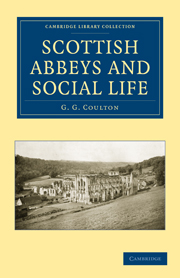Book contents
- Frontmatter
- Contents
- LIST OF ILLUSTRATIONS
- Preface
- Chapter I Celtic Monachism
- Chapter II The Monastic Rules
- Chapter III Monastic Revenues
- Chapter IV How Endowments Came (I)
- Chapter V How Endowments Came (II)
- Chapter VI Monks and Parishes (I)
- Chapter VII Monks and Parishes (II)
- Chapter VIII Charity (I)
- Chapter IX Charity (II)
- Chapter X Monk and Peasant (I)
- Chapter XI Monk and Peasant (II)
- Chapter XII Monastic Housekeeping
- Chapter XIII Church and Scriptorium
- Chapter XIV The Monastic Chronicler
- Chapter XV Schools
- Chapter XVI Art and Learning
- Chapter XVII Professions and Business
- Chapter XVIII Visitation (I)
- Chapter XIX Visitation (II)
- Chapter XX A Voice from the Cloister
- Chapter XXI Conclusion
- Appendixes
- List of Authorities
- Index
Chapter I - Celtic Monachism
Published online by Cambridge University Press: 05 August 2011
- Frontmatter
- Contents
- LIST OF ILLUSTRATIONS
- Preface
- Chapter I Celtic Monachism
- Chapter II The Monastic Rules
- Chapter III Monastic Revenues
- Chapter IV How Endowments Came (I)
- Chapter V How Endowments Came (II)
- Chapter VI Monks and Parishes (I)
- Chapter VII Monks and Parishes (II)
- Chapter VIII Charity (I)
- Chapter IX Charity (II)
- Chapter X Monk and Peasant (I)
- Chapter XI Monk and Peasant (II)
- Chapter XII Monastic Housekeeping
- Chapter XIII Church and Scriptorium
- Chapter XIV The Monastic Chronicler
- Chapter XV Schools
- Chapter XVI Art and Learning
- Chapter XVII Professions and Business
- Chapter XVIII Visitation (I)
- Chapter XIX Visitation (II)
- Chapter XX A Voice from the Cloister
- Chapter XXI Conclusion
- Appendixes
- List of Authorities
- Index
Summary
I cannot do better than to introduce these lectures with a quotation from Professor Seth Pringle-Pattison, whose name I welcome this opportunity of pronouncing before an Edinburgh audience. In the preface to his Idea of God he writes: “This method of construction through criticism is the one which I have instinctively followed in everything I have written. I do not claim that it is the best method; I simply claim that its nature be recognized”. At our present stage of knowledge in monastic history, criticism seems not only the most natural path, but perhaps even the straightest and truest path, towards construction. The mass of documentary material is enormous; much of it has been in print for two or three hundred years. The great Benedictine Mabillon, one of the most laborious and accurate scholars who ever lived, did indeed grapple magnificently with the first half of pre-Reformation monastic history in the Western Church; but death overtook him before he could even begin the bare annals of the second and more important half; still less could he attempt any general synthesis, or explain that revolt against the monks which marks the sixteenth century everywhere, more or less. Many books on monastic history are on the market; yet that of Walter Scott's friend Fosbroke, imperfect as it naturally is, still remains one of the finest and most useful. Of many among the rest we could almost complain as Hallam complained of the current histories of Freemasonry: the subject has seldom been described except by apologists or by adversaries, “both equally mendacious”.
- Type
- Chapter
- Information
- Scottish Abbeys and Social Life , pp. 1 - 20Publisher: Cambridge University PressPrint publication year: 2010First published in: 1933

